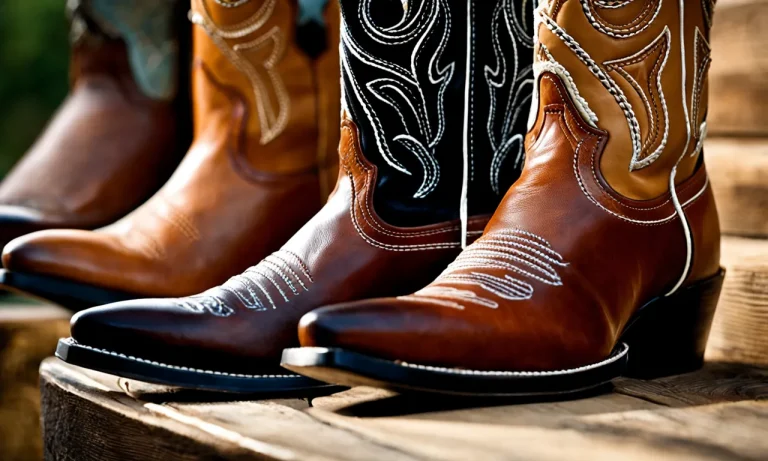Timberland boots have been a staple in American footwear for decades, prized for their rugged durability and classic style. If you’re reading this, chances are you’re wondering—where exactly are Timberland boots made?
If you’re short on time, here’s a quick answer to your question: The majority of Timberland boots sold worldwide are made in Asia, specifically China and Vietnam. However, Timberland still produces certain styles and limited runs of boots in the United States and Dominican Republic.
In this comprehensive guide, we’ll take an in-depth look at Timberland’s manufacturing process, including the different factories they use and what countries produce which boot styles. We’ll also explore Timberland’s brand history and values around global manufacturing.
Whether you’re a boot aficionado or just want to know where your Timberlands hail from, read on for the full story.
A Brief History of the Timberland Brand
Timberland is a renowned footwear and outdoor apparel brand that has been around since 1928. What started as a small, family-owned shoe company has now become a global leader in the industry.
Founded in 1928 as a small family-owned shoe company
Timberland was founded in 1928 by Nathan Swartz in Boston, Massachusetts. Initially, the company focused on making durable, affordable shoes for work and outdoor activities. Nathan’s commitment to quality craftsmanship and attention to detail quickly earned the brand a reputation for excellence.
Throughout the years, Timberland expanded its product line to include clothing and accessories, but their footwear remained their most popular and iconic offering.
Rose to popularity in the 1970s with the waterproof leather boot
In the 1970s, Timberland made a groundbreaking invention that would change the footwear industry forever – the waterproof leather boot. This innovative design, known as the Timberland Yellow Boot, was not only stylish but also highly functional, making it perfect for outdoor activities in any weather condition.
The Yellow Boot quickly gained popularity among workers, hikers, and fashion enthusiasts alike. Its durability, comfort, and distinctive design set it apart from other boots on the market, solidifying Timberland’s position as a leading brand in the industry.
Acquired by VF Corporation but continues to operate independently
In 2011, Timberland was acquired by VF Corporation, a global leader in branded lifestyle apparel, footwear, and accessories. Despite the acquisition, Timberland continues to operate independently, maintaining its unique identity and commitment to quality.
Under the VF Corporation umbrella, Timberland has expanded its reach and global presence. The brand is now sold in over 90 countries, with a wide range of products that cater to various outdoor activities and lifestyles.
Timberland’s commitment to sustainability and social responsibility has also been a driving force behind its success. The company has implemented various initiatives to reduce its environmental impact and support local communities.
Timberland’s Manufacturing Philosophy and Values
When it comes to manufacturing, Timberland has a strong and unwavering commitment to producing high-quality products while also upholding their core values. Let’s take a detailed look at Timberland’s manufacturing philosophy and values.
Commitment to global manufacturing since the 1960s
Timberland’s dedication to global manufacturing can be traced back to the 1960s. They were one of the first footwear companies to expand their operations internationally, recognizing the importance of sourcing materials and expertise from different regions around the world.
This commitment to global manufacturing has allowed Timberland to access a wide range of resources and tap into the knowledge and skills of diverse communities.
By manufacturing in different parts of the world, Timberland is able to bring together the best of each region’s craftsmanship and innovation. This approach not only supports local economies but also ensures that Timberland products are made with the highest standards of quality and durability.
Focus on responsible manufacturing practices
Timberland is deeply committed to responsible manufacturing practices. They strive to minimize their environmental impact and promote sustainability throughout their supply chain. From sourcing materials to manufacturing processes, Timberland integrates sustainability into every aspect of their operations.
One example of Timberland’s dedication to responsible manufacturing is their use of recycled materials. They have developed innovative techniques to incorporate recycled materials, such as plastic bottles and old tires, into their products.
By doing so, they reduce waste and lessen their reliance on virgin resources.
Additionally, Timberland is actively involved in community engagement and social responsibility initiatives. They work closely with their suppliers and partners to ensure fair labor practices and safe working conditions.
This commitment to ethical manufacturing practices extends beyond their own facilities and into the factories they collaborate with.
Partnerships with factories in Asia and Americas
Timberland has built strong and long-lasting partnerships with factories in Asia and the Americas. These partnerships are based on mutual respect, shared values, and a commitment to excellence. Timberland carefully selects their manufacturing partners, ensuring that they align with their high standards of quality, sustainability, and social responsibility.
The factories they work with are equipped with state-of-the-art technology and employ skilled workers who are passionate about their craft. Timberland maintains close relationships with these factories, fostering open communication and collaboration to continuously improve manufacturing processes and product quality.
By partnering with factories in different regions, Timberland is able to leverage the unique expertise and capabilities of each location. This global manufacturing approach allows them to meet the demands of customers worldwide while maintaining their commitment to exceptional craftsmanship and responsible manufacturing.
Where Timberland Sources and Produces Different Boot Styles
Timberland, the renowned footwear brand, sources and produces its various boot styles from different regions around the world. This allows them to leverage the unique expertise and resources available in each location to create high-quality and durable boots.
Leather boots primarily made in China and Vietnam
When it comes to their leather boots, Timberland primarily relies on manufacturing facilities in China and Vietnam. These two countries have a long-standing tradition of leather production and possess the necessary infrastructure to handle the large-scale manufacturing needs of a global brand like Timberland.
The use of these facilities also allows Timberland to keep the costs of production relatively low, making their boots more accessible to a wider consumer base.
Certain classics still produced in the USA and Dominican Republic
Despite the majority of their production being outsourced to China and Vietnam, Timberland still maintains manufacturing facilities in the USA and the Dominican Republic. These locations play a crucial role in producing some of Timberland’s iconic and classic boot styles.
By keeping the production of these boots closer to home, Timberland ensures strict quality control and maintains the craftsmanship that has made these boots so popular over the years.
Shoe production in Italy for European market
Recognizing the demand for premium footwear in the European market, Timberland has established manufacturing partnerships in Italy. These collaborations allow them to tap into the renowned Italian craftsmanship and expertise in shoemaking.
By producing certain boot styles in Italy, Timberland caters to the discerning European consumer who appreciates the quality and attention to detail that comes with shoes made in Italy.
Responsible manufacturing standards upheld across regions
Timberland is committed to upholding responsible manufacturing standards across all their production locations. They prioritize ethical sourcing of materials and have implemented strict guidelines to ensure the fair treatment of workers and the protection of the environment.
By working closely with their suppliers and regularly auditing their manufacturing processes, Timberland strives to maintain transparency and accountability throughout their supply chain.
For more information about Timberland’s manufacturing practices and their commitment to sustainability, you can visit Timberland’s official website.
The Process of Assembling Timberland Boots
Timberland boots are known for their durability, style, and craftsmanship. Each pair goes through a meticulous process to ensure the highest quality standards are met. Here is a detailed look at how Timberland boots are assembled:
Cutting and stitching uppers
The first step in the manufacturing process is cutting and stitching the uppers of the boots. High-quality leather or other materials are carefully selected and cut into the desired shape. Skilled craftsmen then stitch the uppers together, ensuring precision and durability.
This step is crucial as it sets the foundation for the entire boot construction.
Attaching outsoles and welding
Once the uppers are ready, the next step is attaching the outsoles. Timberland boots are known for their rugged and durable outsoles that provide excellent traction. The outsoles are carefully aligned with the uppers and securely attached using advanced techniques such as cementing or stitching.
In some cases, welding is also used to reinforce the bond between the uppers and outsoles, ensuring long-lasting durability.
Quality control and finishing touches
After the boots are assembled, they undergo a rigorous quality control process. Each pair is thoroughly inspected for any defects or imperfections. This includes checking for proper stitching, alignment, and overall construction quality.
Any issues are addressed and corrected before the boots move on to the next stage. Once the quality control is complete, the boots receive their finishing touches, such as branding, laces, and other design elements.
Distribution to global markets
Once the boots pass the quality control and finishing stages, they are ready for distribution to global markets. Timberland has a vast network of distribution centers and retail stores worldwide, ensuring that customers around the world have access to their iconic boots.
The boots are carefully packaged and shipped to various locations, ready to be worn by individuals seeking both fashion and functionality.
It is worth mentioning that Timberland is committed to ethical manufacturing practices. They prioritize sustainability and social responsibility throughout their supply chain. Timberland is a member of the Sustainable Apparel Coalition and actively works towards reducing their environmental impact.
For more information on Timberland’s manufacturing process, you can visit their official website here.
The Future of Timberland Manufacturing
Timberland, the renowned footwear and apparel brand, has always been committed to innovation and sustainability in its manufacturing processes. As the company looks to the future, it is taking bold steps to further improve its manufacturing practices and meet the demands of a rapidly changing world.
Expansion in Vietnam factory announced for 2023
In a recent announcement, Timberland revealed its plans to expand its manufacturing operations in Vietnam. This move comes as part of the company’s strategy to increase production capacity and cater to the growing global demand for its products.
The new factory, set to open in 2023, will not only create job opportunities in the region but also enhance Timberland’s ability to deliver high-quality and sustainable products to its customers worldwide.
By expanding its manufacturing presence in Vietnam, Timberland aims to leverage the country’s skilled workforce and favorable business environment. This strategic decision will enable the brand to streamline its supply chain, reduce costs, and ultimately offer greater value to consumers who appreciate Timberland’s commitment to quality.
Partnerships with suppliers to improve social and environmental practices
Timberland understands the importance of strong partnerships when it comes to improving social and environmental practices in the manufacturing industry. The company actively collaborates with its suppliers to ensure that ethical and sustainable practices are upheld throughout the supply chain.
Timberland’s Supplier Code of Conduct sets clear expectations for its partners regarding labor rights, health and safety, environmental protection, and responsible sourcing. By working closely with suppliers and conducting regular audits, Timberland ensures that these standards are met and continuously improved upon.
In addition to its Code of Conduct, Timberland has implemented various initiatives to support its suppliers in their sustainability efforts. The brand provides training and resources to help suppliers reduce their environmental impact, improve worker well-being, and contribute positively to the communities in which they operate.
New technologies to increase efficiency and sustainability
Timberland recognizes the potential of new technologies in revolutionizing manufacturing processes and driving sustainability. The company is investing in innovative solutions that can enhance efficiency, reduce waste, and minimize its carbon footprint.
One such technology is automation, which enables Timberland to streamline production and minimize human error. By automating certain tasks, the company can increase productivity while reducing waste and energy consumption.
This not only benefits the bottom line but also contributes to a more sustainable manufacturing process.
Furthermore, Timberland is exploring the use of sustainable materials and manufacturing techniques. For instance, the brand has introduced the use of recycled materials in its products, reducing the reliance on virgin resources.
Additionally, Timberland is actively researching and implementing renewable energy sources in its manufacturing facilities to reduce greenhouse gas emissions.
As Timberland looks to the future, it remains committed to pushing the boundaries of innovation in manufacturing. By expanding its operations, fostering strong partnerships, and embracing new technologies, the brand is paving the way for a more sustainable and efficient future in the footwear industry.
Conclusion
Timberland has relied on a global manufacturing strategy since their early days, producing boots in both America and overseas. While Asia now makes up the majority of production, Timberland maintains a strong commitment to responsible labor practices wherever boots are made.
Through a diverse network of factories and supply chains, Timberland is able to bring their iconic boots to customers worldwide. Understanding the journey of Timberland boots, from raw materials to store shelves, provides insight into the brand’s values and quality standards.
As Timberland expands production abroad and integrates new technologies, their focus remains on making enduring, responsibly-crafted footwear. The global effort behind Timberland’s boots contributes to their worldwide popularity and appeal.






